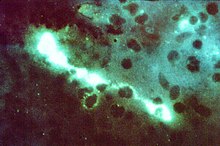Chlamydophila
| Chlamydophila | |
|---|---|

| |
| Chlamydophila psittaci | |
| Scientific classification | |
| Domain: | Bacteria |
| Phylum: | Chlamydiota |
| Class: | Chlamydiia |
| Order: | Chlamydiales |
| Family: | Chlamydiaceae |
| Genus: | Chlamydophila Everett, Bush & Andersen 1999 |
| Type species | |
Chlamydophila psittaci (Lillie 1930) Everett, Bush & Andersen 1999
| |
| Species[1] | |
| |
| Synonyms | |
| |
Chlamydophila is a controversial bacterial genus belonging to the family Chlamydiaceae.[2]
Taxonomy
All
Chlamydophila was recognized by a number of scientists in 1999, The history of the classification and reclassification is as follows.
Earlier criteria for differentiation of chlamydial species did not always work well. For example, at that time genus
The systematic
Comparative genomic analyses in 2006 identified a number of signature proteins that were uniquely present in species from the genera Chlamydia and Chlamydophila, which supported the distinctness of Chlamydophila.[6] This view was challenged three years later by newer whole genome analysis techniques leading to a proposal to "reunite the Chlamydiaceae into a single genus, Chlamydia".[7] By the 2010s this reclassification "was not wholly accepted or adopted"[8] among microbiologists, which "resulted in a reversion to the single, original genus Chlamydia, which now encompasses all 9 species including Chlamydia psittaci."[8] As of 2013, Chlamydophila was still mentioned in some databases, but controversial.[9] The merger of the genus Chlamydophila back into the genus Chlamydia is now generally accepted.[10][11][12][13]
Chlamydophila differentiation
According to the authors of the 1999 study, the
| Genus | Approximate Genome Size (million DNA base pairs) | Detectable Glycogen | Number of Ribosomal Operons |
|---|---|---|---|
| Chlamydophila | 1.2 | No | 1 |
| Chlamydia | 1.0 | Yes | 2 |
Phylogeny
| 16S rRNA based | 120 marker proteins based GTDB 08-RS214[17][18][19] | |||||||||||||||||||||||||||||||||||||||||||||||||||||||||||||||||||||||||||||||||||||||||||||||||||||||||||||||||||||||||||||||||||||||||||||
|---|---|---|---|---|---|---|---|---|---|---|---|---|---|---|---|---|---|---|---|---|---|---|---|---|---|---|---|---|---|---|---|---|---|---|---|---|---|---|---|---|---|---|---|---|---|---|---|---|---|---|---|---|---|---|---|---|---|---|---|---|---|---|---|---|---|---|---|---|---|---|---|---|---|---|---|---|---|---|---|---|---|---|---|---|---|---|---|---|---|---|---|---|---|---|---|---|---|---|---|---|---|---|---|---|---|---|---|---|---|---|---|---|---|---|---|---|---|---|---|---|---|---|---|---|---|---|---|---|---|---|---|---|---|---|---|---|---|---|---|---|---|---|
|
|
See also
References
- ^ J.P. Euzéby. "Chlamydophila". List of Prokaryotic names with Standing in Nomenclature. Retrieved 2011-06-11.
- ^ Chlamydophila at the U.S. National Library of Medicine Medical Subject Headings (MeSH)
- PMID 10319462.
- ^ LPSN.
- PMID 11211261.
- PMID 16436211.
- PMID 19281563.
- ^ S2CID 26000244.
- ^ "Chlamydia/Chlamydophila group". NCBI taxonomy database. National Center for Biotechnology Information, U.S. National Library of Medicine. Retrieved 2013-03-26.
Given the contentious nature of the issue, the NCBI Taxonomy Database retains both genus names for use by submitters.
- S2CID 31730015.
- PMID 24882432.
- PMID 25618261.
- PMID 29310550.
- ^ "The LTP". Retrieved 20 November 2023.
- ^ "LTP_all tree in newick format". Retrieved 20 November 2023.
- ^ "LTP_08_2023 Release Notes" (PDF). Retrieved 20 November 2023.
- ^ "GTDB release 08-RS214". Genome Taxonomy Database. Retrieved 10 May 2023.
- ^ "bac120_r214.sp_label". Genome Taxonomy Database. Retrieved 10 May 2023.
- ^ "Taxon History". Genome Taxonomy Database. Retrieved 10 May 2023.
External links
- Chlamydophila genomes and related information at PATRIC, a Bioinformatics Resource Center funded by NIAID
- Taxonomic Outline of the Procaryotes, Bergey's Manual of Systematic Bacteriology, Second Edition Release 1.0, April c. [1]
